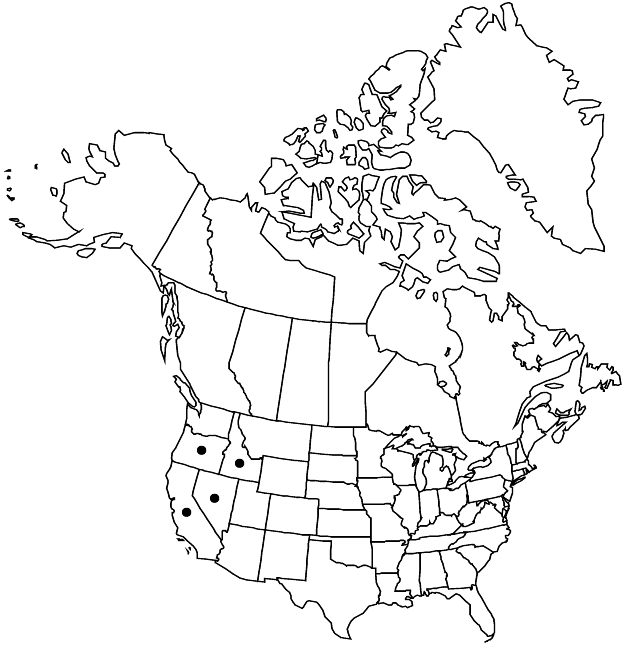Difference between revisions of "Eriogonum spergulinum"
Proc. Amer. Acad. Arts 7: 389. 1868.
RevisionBot (talk | contribs) m (Bot: Adding category Revision Pending) |
imported>Volume Importer |
||
| Line 6: | Line 6: | ||
|place=7: 389. 1868 | |place=7: 389. 1868 | ||
|year=1868 | |year=1868 | ||
| + | }} | ||
| + | |special_status={{Treatment/ID/Special_status | ||
| + | |code=F | ||
| + | |label=Illustrated | ||
| + | }}{{Treatment/ID/Special_status | ||
| + | |code=E | ||
| + | |label=Endemic | ||
}} | }} | ||
|basionyms= | |basionyms= | ||
| Line 23: | Line 30: | ||
-->{{Treatment/Body | -->{{Treatment/Body | ||
| − | |distribution= | + | |distribution=Calif.;Idaho;Nev.;Oreg. |
|discussion=<p>Varieties 3 (3 in the flora).</p> | |discussion=<p>Varieties 3 (3 in the flora).</p> | ||
|tables= | |tables= | ||
| Line 61: | Line 68: | ||
|basionyms= | |basionyms= | ||
|family=Polygonaceae | |family=Polygonaceae | ||
| − | |distribution= | + | |distribution=Calif.;Idaho;Nev.;Oreg. |
|reference=None | |reference=None | ||
|publication title=Proc. Amer. Acad. Arts | |publication title=Proc. Amer. Acad. Arts | ||
|publication year=1868 | |publication year=1868 | ||
| − | |special status= | + | |special status=Illustrated;Endemic |
| − | |source xml=https:// | + | |source xml=https://bitbucket.org/aafc-mbb/fna-data-curation/src/2e0870ddd59836b60bcf96646a41e87ea5a5943a/coarse_grained_fna_xml/V5/V5_847.xml |
|subfamily=Polygonaceae subfam. Eriogonoideae | |subfamily=Polygonaceae subfam. Eriogonoideae | ||
|genus=Eriogonum | |genus=Eriogonum | ||
| Line 73: | Line 80: | ||
}}<!-- | }}<!-- | ||
| − | --> | + | -->[[Category:Treatment]][[Category:Eriogonum subg. Ganysma]] |
| − | |||
| − | [[Category:Treatment]] | ||
| − | [[Category:Eriogonum subg. Ganysma | ||
| − | |||
Revision as of 22:14, 5 November 2020
Herbs, prostrate to spreading or erect, annual, 0.5–4 dm, glabrous or glandular and short-hispid, greenish, grayish, or reddish. Stems: caudex absent; aerial flowering stems prostrate to erect, solid, not fistulose, 0.1–0.5 dm, glabrous or glandular and short-hispid. Leaves basal and cauline; basal: petiole 0.05–0.3 cm, hispid, blade linear, (0.3–)1–3(–4) × 0.05–0.3 cm, short-hispid, margins plane or revolute, ciliate; cauline sessile, blade linear, 0.3–2.5 × 0.05–0.3 cm, similar to basal blade. Inflorescences cymose, open to diffuse, 4–25 × 5–35 cm; branches sparsely hispid to puberulent, internodes usually glandular; bracts 3–6, semileaflike, 2–10 × 0.5–2 mm. Peduncles erect, straight, filiform, 0.4–1.5 cm, glabrous. Involucres turbinate, 0.5–1 × 0.4–0.8 mm, glabrous; teeth 4, erect, 0.2–0.4 mm. Flowers 1.5–3.5 mm; perianth white with greenish to reddish midribs, becoming pinkish to rose, glabrous or sparsely pubescent; tepals monomorphic, oblong; stamens included, 0.5–2 mm; filaments usually glabrous. Achenes brown to blackish, lenticular, 1.5–2.3 mm, glabrous.
Distribution

Calif., Idaho, Nev., Oreg.
Discussion
Varieties 3 (3 in the flora).
Selected References
None.
Lower Taxa
Key
| 1 | Branch internodes not glandular; plants prostrate to ascending; s Sierra Nevada, California | Eriogonum spergulinum var. pratense |
| 1 | Branch internodes glandular; plants erect | > 2 |
| 2 | Flowers 1.5-2.5 mm; Transverse, Sierra Nevada, and North Coast Ranges of nw, sw, and e California and w Nevada, also s Oregon, c Idaho | Eriogonum spergulinum var. reddingianum |
| 2 | Flowers 2.5-3.5 mm; c Sierra Nevada, California | Eriogonum spergulinum var. spergulinum |